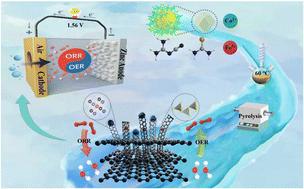可充电锌空气电池ORR/OER催化剂中ZnS与CoFe合金耦合的碳纳米管连接策略
IF 9.2
1区 化学
Q1 CHEMISTRY, MULTIDISCIPLINARY
引用次数: 0
摘要
为了解决不同氧还原反应(ORR)和析氧反应(OER)活性位点的耦合问题,提出了碳纳米管连接策略,这是提高可充电锌空气电池(ZABs)催化剂性能的关键。采用该策略,通过CNTs将ZnS、CoFe合金和缺陷碳面相结合,合成了FeCo-S/Z8-NC复合催化剂。feo - s /Z8-NC中的大多数活性位点被CNTs包裹,形成一个保护壳,提高了稳定性。FeCo-S/Z8-NC表现出优异的双功能催化活性(ORR: E1/2 = 0.86 V, OER: Ej=10 = 1.52 V),优于商用Pt/C + RuO2催化剂。当应用于ZABs时,它提供了1.56 V的高开路电压,卓越的长期充放电稳定性(270 h),以及在宽温度范围内的出色功率密度(- 10°C: 114.52 mW cm - 2, 25°C: 162.82 mW cm - 2和60°C: 229.49 mW cm - 2)。本研究为开发高效、低成本、环保的ORR/OER催化剂,促进ZABs的可持续应用提供了可行的途径。本文章由计算机程序翻译,如有差异,请以英文原文为准。

A CNT-connection strategy of coupling ZnS and a CoFe alloy in ORR/OER catalysts of rechargeable zinc–air batteries
The CNT-connection strategy was proposed to address the challenge of coupling diverse oxygen reduction reaction (ORR) and oxygen evolution reaction (OER) active sites, which was critical for enhancing catalyst performance in rechargeable zinc–air batteries (ZABs). Through this strategy, a composite catalyst (FeCo-S/Z8-NC) was synthesized by integrating ZnS, a CoFe alloy and defective carbon planes via CNTs. Most active sites in FeCo-S/Z8-NC were encapsulated by CNTs, forming a protective shell that improved stability. FeCo-S/Z8-NC exhibited excellent bifunctional catalytic activity (ORR: E1/2 = 0.86 V, OER: Ej=10 = 1.52 V), which outperformed the commercial Pt/C + RuO2 catalyst. When applied in ZABs, it delivered a high open-circuit voltage of 1.56 V, remarkable long-term charge–discharge stability (270 h), and outstanding power densities across a wide temperature range (−10 °C: 114.52 mW cm−2, 25 °C: 162.82 mW cm−2, and 60 °C: 229.49 mW cm−2). This work provided a feasible approach for developing efficient, low-cost and eco-friendly ORR/OER catalysts, promoting the sustainable application of ZABs.
求助全文
通过发布文献求助,成功后即可免费获取论文全文。
去求助
来源期刊

Green Chemistry
化学-化学综合
CiteScore
16.10
自引率
7.10%
发文量
677
审稿时长
1.4 months
期刊介绍:
Green Chemistry is a journal that provides a unique forum for the publication of innovative research on the development of alternative green and sustainable technologies. The scope of Green Chemistry is based on the definition proposed by Anastas and Warner (Green Chemistry: Theory and Practice, P T Anastas and J C Warner, Oxford University Press, Oxford, 1998), which defines green chemistry as the utilisation of a set of principles that reduces or eliminates the use or generation of hazardous substances in the design, manufacture and application of chemical products. Green Chemistry aims to reduce the environmental impact of the chemical enterprise by developing a technology base that is inherently non-toxic to living things and the environment. The journal welcomes submissions on all aspects of research relating to this endeavor and publishes original and significant cutting-edge research that is likely to be of wide general appeal. For a work to be published, it must present a significant advance in green chemistry, including a comparison with existing methods and a demonstration of advantages over those methods.
 求助内容:
求助内容: 应助结果提醒方式:
应助结果提醒方式:


